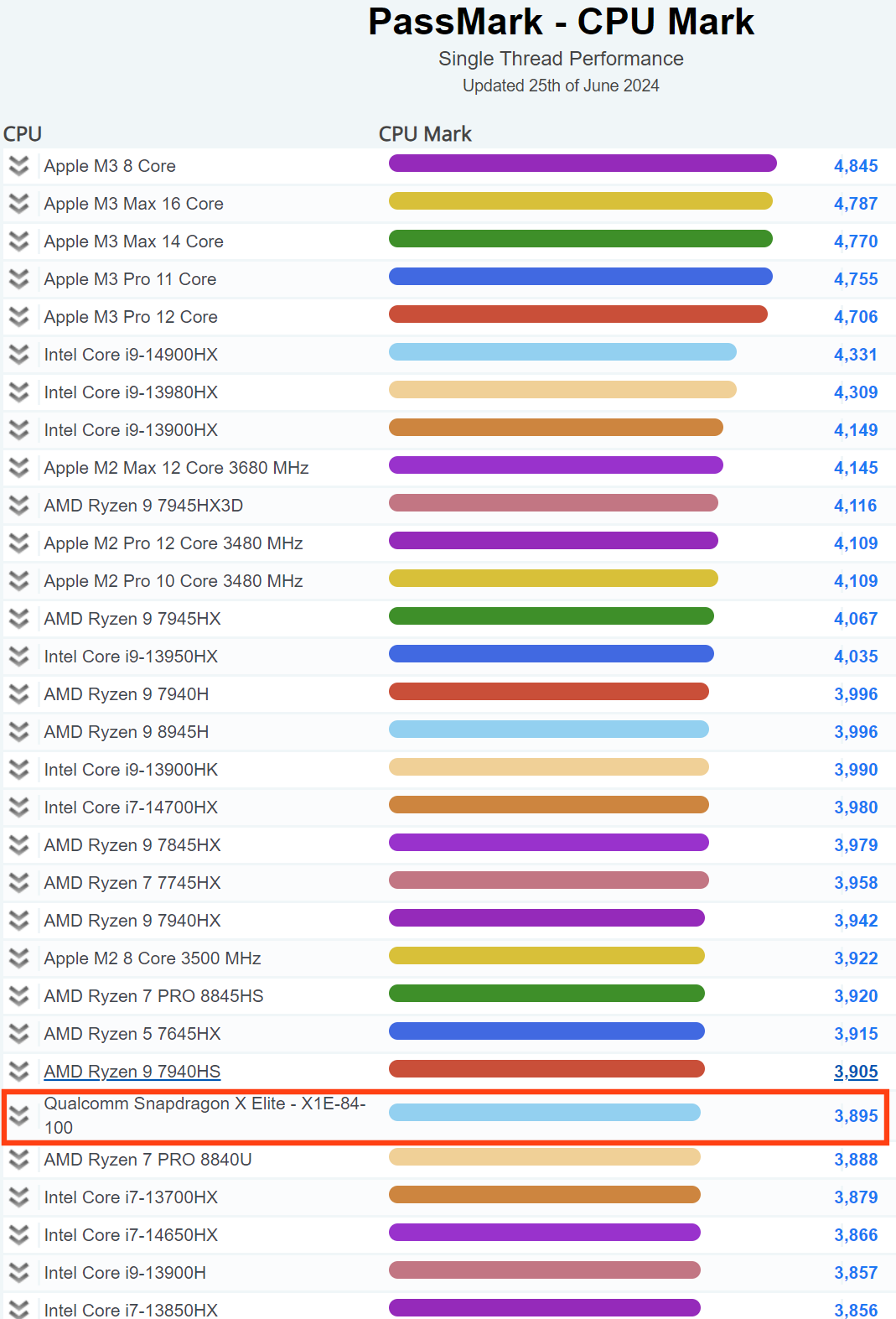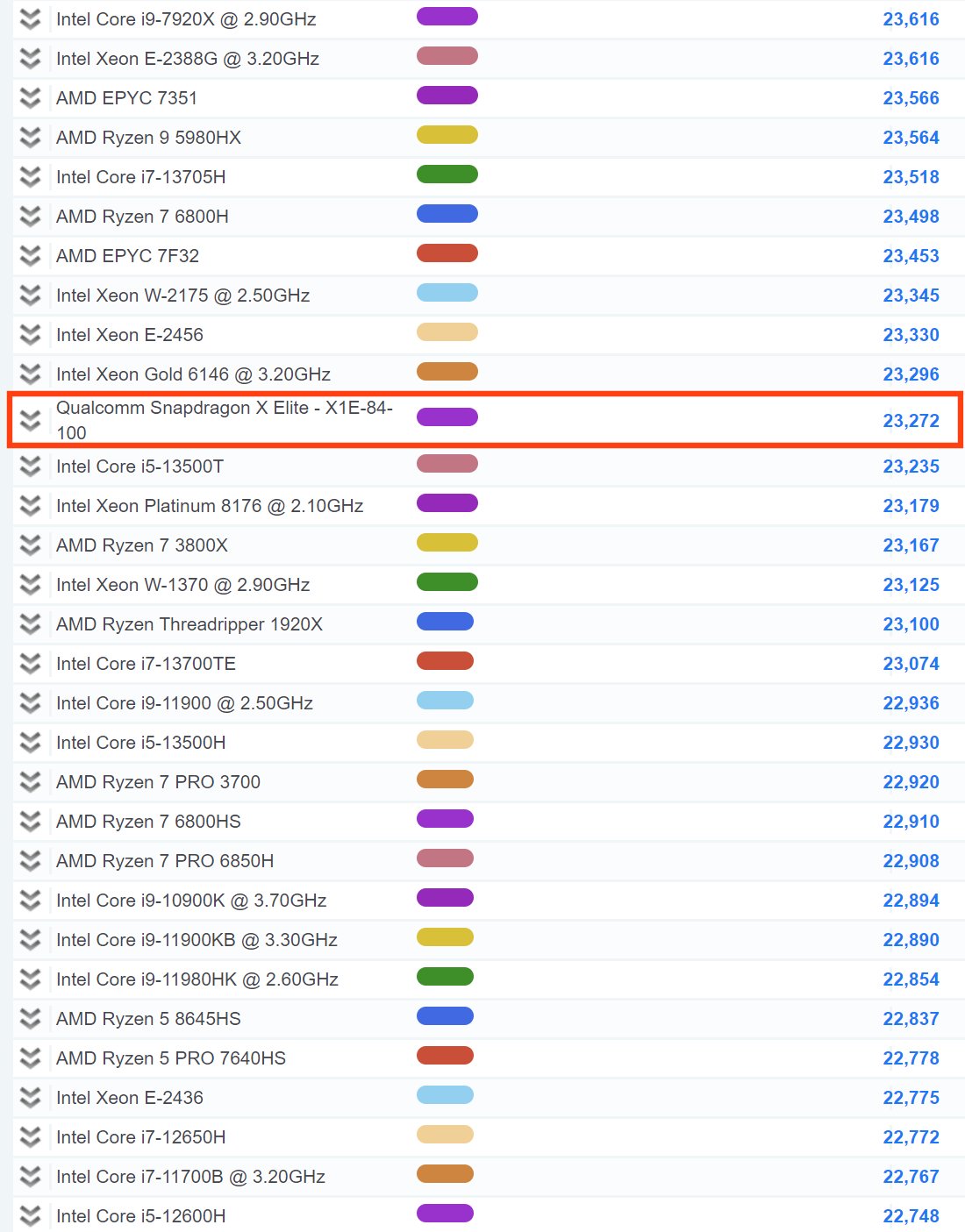Qualcomm's flagship Snapdragon X Elite in PassMark: Fails to Beat Apple's M3

Qualcomm's range-topping Snapdragon X Elite X1E-84-100 appears to have been benchmarked in PassMark, and its results were quite a mixed bag. On the one hand, a low-power Arm-based processor beats the more power-hungry x86 CPUs from AMD and Intel, but on the other hand, it fails to beat its fellow Arm-based rivals from Apple. When it comes to graphics, things do not look exactly good for gamers, either.
Qualcomm's Snapdragon X Elite X1E-84-100 processor with 12 cores running at 3.80 GHz to 4.20 GHz scores 3,895 points in the single-threaded PassMark benchmark. This is high enough to be on par with Apple's M2 (3,922 points, eight cores, 3.48 GHz), Intel's Core i5-13500 (3,890, 14 cores, 20 threads, 2.50 GHz to 4.80 GHz, 65W – 154W) or Core i7-13700 HX (3,879, 8C/16T, 2.10 GHz to 5.0 GHz, 45W to 157W). But this is behind Apple's 12-core M2 Pro running at 3.48 GHz which scores 4,109 points when it is properly cooled, and is significantly behind M3/M3 Max which operate at 4.0 GHz and score 4,770 to 4,845, well ahead of Qualcomm's flagship.


When it comes to PassMark's multi-thread benchmark, Qualcomm's 12-core Snapdragon X Elite X1E-84-100 processor scores 23,272 points, which is ahead of Apple's 9-core M4 (22,445 points, inside a tablet and without active cooling) and Intel's Core i5-12600H (22,748 points, 12C/16T, 2.70 GHz to 4.50 GHz, 35W to 95W). However, the system-on-chip is significantly behind Apple's 14-core M3 Max (36,346), 12-core M3 Pro (27,318), and even 12-core M2 Pro (26,406).
As far as GPU performance in the PassMark benchmark is concerned, Qualcomm's Snapdragon X Elite X1E-84-100 with Adreno GPU scores 2,759 points, which is in line with GeForce MX 350 (2,807).
While the numbers show that Qualcomm's Snapdragon X Elite X1E-84-100 processor is not exactly a performance champion in PassMark, keep in mind that we are dealing with only one synthetic benchmark that is not even the most popular one. Another point to consider is that Qualcomm has never advertised thermal envelope or power consumption for its Snapdragon X Elite processors. When comparing them to desktop or laptop x86 CPUs, we may be comparing Apples and Bananas to Oranges.
Yet, the power consumption of Snapdragon X Elite X1E-84-100 should be comparable with some of Apple's latest processors (say, 12-core M3 Max) and if this is the case, then Qualcomm's SoC just cannot beat its direct competitor in traditional workloads.
In any case, for now, it is too early to draw any conclusions as benchmark results are unofficial and we may be dealing with pre-production hardware and software (though chances that this is the case are low).
Get Tom's Hardware's best news and in-depth reviews, straight to your inbox.

Anton Shilov is a contributing writer at Tom’s Hardware. Over the past couple of decades, he has covered everything from CPUs and GPUs to supercomputers and from modern process technologies and latest fab tools to high-tech industry trends.
-
Notton I wish you could filter out less relevant data on that site.Reply
I want to see and compare mobile and (some) desktop, but not workstation xeon/epyc/threadripper. -
CmdrShepard As expected, all of them are just talk while Apple quietly sits in the corner and does their thing.Reply -
salgado18 Oh no, really? I try to let it be, but with a third of all benchmarks for Apple, another third for Intel and another third for AMD, why compare it only with Intel? Is AMD dead or something? Is it so hard to say:Reply
This is high enough to be on par with Apple's M2 (3,922 points, eight cores, 3.48 GHz), Core i7-13700 HX (3,879, 8C/16T, 2.10 GHz to 5.0 GHz, 45W to 157W) or Ryzen 9 7940HS (3905, 8C/16T, 4.0 GHz to 5.2 GHz, 35W to 54W)
Same for multi-threaded? All Apple and one Intel?
I'll let GPU pass, since all AMD comparable GPUs are previous gen, even though there are plenty of laptops using them today.
I'm really sorry for the rant, but with a sample size of 10 CPUs (not counting the Snapdragon), there's no excuse to leave out the second x86 vendor out of two. -
DS426 Say it aint so!? Apple and their bottomless pockets, completely closed ecoysystem, and custom silicon beats everyone else?? Wow man, what would life be without Apple?!?Reply -
Amdlova Apple still winning the qualcomm cpus over years and years...Reply
Amd and Intel need to answer that treat so fast before the windows 12 espionage edition comes out. The Power of IA meets the true power of ARM -
bit_user Maybe I missed it, but I think this article seemed to omit the most basic detail, which is whether or not the PassMark software was natively compiled for Arm. Does anyone know? What about Apple's entry - did that us a build for MacOS, or was it also running under emulation?Reply -
Sam Bridges Reply
LOL. The blind hate is hilarious.DS426 said:Say it aint so!? Apple and their bottomless pockets, completely closed ecoysystem, and custom silicon beats everyone else?? Wow man, what would life be without Apple?!?
I mean, I’m not defending no copro overlords. I understand the Apple hate on other, more important, issues. But wow, it’s amazing how people turn it around even when the product is good.
I assume you dump on Microsoft as well for Surface laptops being an arguably well designed product, for instance. Right? Those trillions of dollars muppets, of course their new laptops are actually well built. Right?
Cheers mate. Don’t be mad at me, I had to jest about it. It’s too funny. 😂